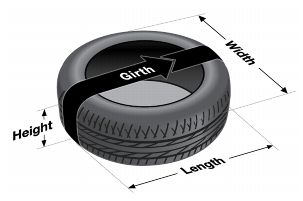The Postal Service™ clarifies the measurement of tires, and other similarly shaped items, to determine mailability and whether dimensional weight, balloon rate, or oversized prices apply. The following describes the methods used to make these measurements.
Mailability
To determine mailability, add the length and the girth. Length is the distance across the tire at its widest point. Girth is the distance around the whole tire at its widest point, as though the tire did not have an opening in the middle. Both measurements are displayed in the diagram.
If the length plus the girth is 108 inches or less, the item is mailable to any domestic destination. If the length plus the girth is greater than 108 inches, but not greater than 130 inches, the item is mailable at the oversized Parcel Post® price.

Balloon Pricing for Priority Mail and Parcel Post
Balloon pricing applies when all of the following are true:
n The length plus girth is over 84 inches (but not more than 108 inches).
n The item weighs less than 20 pounds.
n The package is being shipped to zones 1–4 for Priority Mail® and all zones for Parcel Post.
Dimensional Weight Pricing for Priority Mail
Dimensional weight pricing applies to items shipped to zones 5–8 as follows:
n Measure the length, width, and height in inches at their extreme dimensions (as shown in the diagram)
n Round off each measurement to the nearest whole inch.
n Multiply the length by the width by the height, and multiply the result by the nonrectangular adjustment factor of 0.785. (L x W x H) x 0.785
n If the final result exceeds 1,728 cubic inches, divide the result by 194 and round up (see DMM 604.7) to the next whole number to determine the dimensional weight in pounds.
n The mailer pays the actual weight, or the dimensional weight, whichever is greater.
n If the dimensional weight exceeds 70 pounds; the mailer pays the 70-pound price.
This is consistent with the way the tire would be measured if it were wrapped leaving no hole in the middle.
Additional information can be found in Mailing Standards of the United States Postal Service, Domestic Mail Manual (DMM®) part 123, and in Quick Service Guide (QSG) 120, Priority Mail, found on the Postal Explorer® website at http://pe.usps.com.
Mailing Standards, Pricing, 10-22-09
